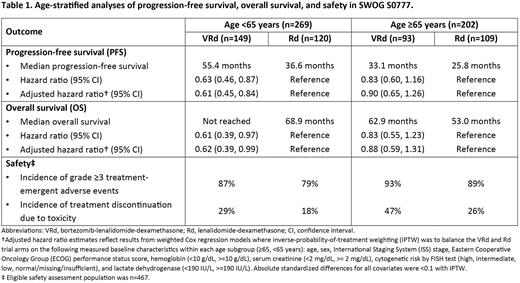Abstract
Introduction: The SWOG S0777 phase 3 randomized controlled trial demonstrated that treatment with bortezomib-lenalidomide-dexamethasone (VRd) resulted in superior progression-free survival (PFS) and overall survival (OS) compared to lenalidomide-dexamethasone (Rd) alone in patients with newly diagnosed multiple myeloma (NDMM) without intent for immediate transplant. The trial population included a combination of transplant-ineligible patients and transplant-eligible patients who chose to defer or decline upfront autologous stem transplantation. The present stratified analyses explored possible treatment effect heterogeneity based on age, with a cutpoint of ≥65 years used as a proxy for transplant eligibility status (Mian, J Geriatr Oncol, 2020).
Methods: Individual patient-level data from the SWOG S0777 trial (primary data cut; median follow-up 55 months) were obtained from the National Cancer Institute. Patients with NDMM who participated in the SWOG S0777 trial meeting inclusion criteria and with valid informed consent were stratified based on age at enrollment (≥65 vs. <65 years). Within these strata, patients randomized to VRd or Rd were compared with respect to PFS, OS, incidence of grade ≥3 treatment-emergent adverse events (TEAEs), and treatment discontinuation due to toxicity. Patients were analyzed according to the intent-to-treat principle. Binary outcomes were compared using proportions; time-to-event outcomes were analyzed using Kaplan-Meier estimators and Cox regression. To adjust for potential imbalances across treatment arms on baseline patient characteristics within the age subgroups, sensitivity analyses were conducted in which inverse-probability-of-treatment weighting (IPTW) was used to balance the VRd and Rd trial arms on key measured baseline characteristics within strata defined by age.
Results: A total of 471 patients with NDMM (median age: 63 years, range: 29-87) were eligible for analysis. In patients aged <65 years at enrollment (n=269), median PFS was 55.4 and 36.6 months for VRd and Rd patients, respectively (HR=0.63, 95% CI: 0.46, 0.87); median OS was not reached and 68.9 months (HR=0.61, 95% CI: 0.39, 0.97). The incidence of grade ≥3 TEAEs and treatment discontinuation due to toxicity was 87% and 29% in VRd patients as compared with 79% and 18% in Rd patients.
In patients aged ≥65yr at enrollment (n=202), median PFS was 33.1 and 25.8 months for VRd and Rd patients (HR=0.83, 95% CI: 0.60, 1.16); median OS was 62.9 months and 53.0 months (HR=0.83, 95% CI: 0.55, 1.23). The incidence of grade ≥3 TEAEs and treatment discontinuation due to toxicity was 93% and 47% in VRd patients as compared with 89% and 26% in Rd patients. Results from the covariate-adjusted sensitivity analyses were consistent with the primary results (Table 1).
Discussion: The present analyses shed light on possible treatment effect heterogeneity based on age in the SWOG S0777 trial. The estimated relative benefit of VRd vs. Rd with respect to both PFS and OS was smaller in magnitude for patients aged ≥65 years (proxy for transplant ineligible) relative to patients <65 years (proxy for transplant deferred). In addition, grade ≥3 TEAEs and treatment discontinuations due to toxicity were higher in both treatment arms in patients aged ≥65 years relative to younger patients. Limitations of the present study include the fact that it was a post hoc subgroup analysis with a limited number of patients within each age stratum, and issues of generalizability of these findings to the contemporary use of VRd in older patients with NDMM where better-tolerated subcutaneous bortezomib and modified dosing schedules may be preferred. Anticipated read-outs from ongoing trials of VRd in transplant-ineligible patients with NDMM using subcutaneous bortezomib may help to further clarify the level of benefit of VRd in older adults with NDMM.
Disclosures
Durie:Celgene/BMS: Consultancy, Honoraria; Amgen: Consultancy, Honoraria; Takeda: Consultancy, Honoraria; Janssen: Consultancy, Honoraria. Lam:Janssen: Current Employment. Ngo:Johnson & Johnson: Current Employment. Pei:Janssen: Current Employment, Current equity holder in publicly-traded company. Ammann:Johnson & Johnson: Current Employment, Current equity holder in publicly-traded company.
Author notes
Asterisk with author names denotes non-ASH members.


This feature is available to Subscribers Only
Sign In or Create an Account Close Modal